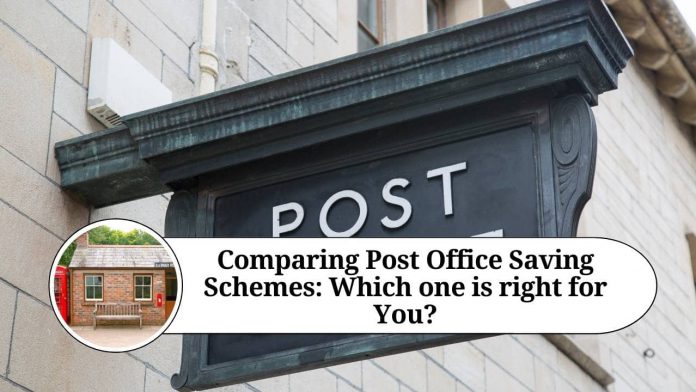Post office saving schemes are a popular way for people in India to save money and earn interest. These schemes are backed by the government and are considered to be very safe investments. In this blog, we will explore some of the most popular post office saving schemes and how they work.
Post Office Savings Account
The Post Office Savings Account is a basic savings account that can be opened by anyone. It requires a minimum deposit of Rs. 500 and can be opened with just Rs. 10. The account earns an interest rate of 4% per annum, which is paid quarterly. The account can be opened by an individual, a minor, or a joint account holder.
Post Office Time Deposit
The Post Office Time Deposit is a fixed deposit scheme that has a maturity period ranging from 1 year to 5 years. The minimum investment for this scheme is Rs. 1,000. The interest rates for this scheme are as follows:
1-year deposit: 5.5% per annum
2-year deposit: 5.5% per annum
3-year deposit: 5.5% per annum
5-year deposit: 6.7% per annum
Post Office Monthly Income Scheme
The Post Office Monthly Income Scheme is a popular investment option for those who want a steady source of income. This scheme has a maturity period of 5 years and earns an interest rate of 6.6% per annum. The minimum investment for this scheme is Rs. 1,000, and there is no maximum limit. The interest is paid out monthly, which makes it a good option for those who need a regular income.
4. National Savings Certificates
National Savings Certificates (NSCs) are fixed-income investments that have a maturity period of 5 years. These certificates can be purchased from any post office and are available in denominations of Rs. 100, Rs. 500, Rs. 1,000, Rs. 5,000, and Rs. 10,000. The interest rate for NSCs is 6.8% per annum, compounded annually. The interest earned on NSCs is eligible for tax deduction under Section 80C of the Income Tax Act.
5. Public Provident Fund
The Public Provident Fund (PPF) is a long-term investment option that has a maturity period of 15 years. The minimum investment for PPF is Rs. 500, and the maximum investment is Rs. 1.5 lakh per year. The interest rate for PPF is 7.1% per annum, compounded annually. The interest earned on PPF is tax-free, and the investment amount is eligible for tax deduction under Section 80C of the Income Tax Act.
Read Other Useful Blogs:
Conclusion
Post office saving schemes are a great way to save money and earn interest. They are backed by the government and are considered to be very safe investments. There are various schemes available to suit different needs and investment goals. One can choose a scheme based on their investment horizon and risk appetite.
Frequently Asked Questions
Q.) Who can invest in post office saving schemes?
A: Any Indian citizen can invest in post office saving schemes, including individuals, minors, and joint account holders.
Q.)What is the minimum investment required for post office saving schemes?
A: The minimum investment amount varies for different schemes. For example, the Post Office Savings Account can be opened with just Rs. 10, while the minimum investment for the Post Office Monthly Income Scheme is Rs. 1,000.
Q.)How are the interest rates determined for post office saving schemes?
A: The interest rates for post office saving schemes are determined by the government of India and are subject to change periodically. The interest rates are based on prevailing market conditions and are usually higher than bank fixed deposit rates.
Q.)Are post office saving schemes safe?
A: Yes, post office saving schemes are considered to be safe investments as they are backed by the government of India. The schemes are designed to provide a reliable source of income for investors and offer guaranteed returns.
Q.)Are post office saving schemes tax-free?
A: The tax treatment of post office saving schemes varies depending on the scheme. For example, the interest earned on National Savings Certificates is eligible for tax deduction under Section 80C of the Income Tax Act, while the interest earned on Public Provident Funds is tax-free.
Q.)Can I withdraw my investment before the maturity date?
A: Yes, you can withdraw your investment before the maturity date, but this may result in a penalty. The penalty amount varies for different schemes and depends on the duration for which the investment has been held.
Q.)How can I open a post office saving scheme account?
A: You can visit any post office and fill out the necessary forms to open a post office saving scheme account. You will need to provide identity and address proof along with the investment amount.
Q.)Can I transfer my post office saving scheme account to another post office?
A: Yes, you can transfer your post office saving scheme account to another post office. You will need to fill out the necessary forms and submit them to the post office where you have the account. The process can take a few weeks to complete.
Q.)What happens to my post office saving scheme account if I pass away?
A: In the event of the account holder’s death, the account can be transferred to a nominee or legal heir. The nominee or legal heir will need to provide the necessary documents to transfer the account.




















